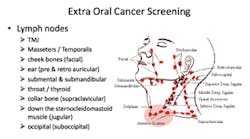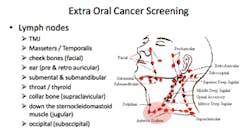Rinse helps cancer patients: NeutraSal minimizes effects of radiation
In the past six months within my circle of clients, colleagues, family, and friends, there have been two confirmed diagnoses of thyroid cancer. Both cases were detected with an external head and neck exam — one provided by a dentist and the other by a hygienist.
Most patients diagnosed with head and neck cancer will end up receiving some type of chemo or radiation therapy. These treatments, while an important part of treating the cancer, can bring on a painful and debilitating condition called oral mucositis (OM) or stomatitis.
OM is characterized by red, shiny, and/or swollen oral tissues. Ulcerations on the tongue and gums are common. Difficulty swallowing or talking, general dryness, mild burning, or pain when eating can also occur. In severe cases, the condition is called confluent mucositis, and the mucus membrane of the patient’s entire mouth and tongue can be coated by white mucus that is up to 1 mm thick.
OM impacts over 400,000 cancer patients. More than 40% of all patients undergoing conventional chemotherapy and 97% to 100% of patients undergoing conventional radiation or bone marrow transplant therapy are affected. OM generally begins five to 10 days following the initiation of chemotherapy or radiation therapy, lasting anywhere from one week to six weeks or more.(1,2,3)
Treating oral mucositis
I’d like to introduce you to a product designed to maintain and heal the oral mucosa called NeutraSal by Invado Pharmaceuticals.
NeutraSal comes in single-use packets of dissolving powder, which, when mixed with water, creates an oral rinse supersaturated with calcium and phosphate ions.These ions diffuse into the intercellular spaces in the epithelium and permeate the mucosal lesions in mucositis. The advanced electrolyte solution mimics natural saliva and helps to restore the normal ionic and pH balance in the oral cavity aiding healing in the following ways:
- Calcium ions play a crucial role in the inflammatory process, the blood clotting cascade, and tissue repair
- Phosphate ions may help repair damaged mucosal surfaces
- Calcium and phosphate ions aid in the prevention of caries
- Bicarbonate reduces the acidity of the oral fluids, dilutes the accumulation of mucus, and discourages the colonization of yeast
When NeutraSal is used at the start of chemotherapy or radiation therapy, it can help maintain the correct oral environment and initiate healing of the oral mucosa. NeutraSal has also been shown to be effective in the treatment of Sjögren's syndrome and the resulting xerostomia.(1,2,3)
NeutraSal is available by prescription. I appreciate that there is a direct access program that provides products for all patients experiencing oral mucositis or xerostomia who require NeutraSal treatment, regardless of their insurance or financial situation. With each prescription, the patient is shipped either the complementary Sjögren's support kit or the oral mucositis support kit.
Please visit the NeutraSal website, www.neutrasal.com, for patient testimonials, clinical trials, and research, as well as information on how to order and prescribe NeutraSal. NeutraSal does not contain sugar, yeast, wheat, gluten, soy, milk, egg, shellfish, or any preservatives.
Take a proactive role
With the incidence of head and neck cancers still rising, the importance of external head and neck exams cannot be overstated. Despite the fact that we all learned how to do these exams in school, I find that very few hygienists and dentists are actually providing a comprehensive head and neck exam. This exam includes palpating the following:
- Temporomandibular joint and muscles
- Masseters
- Anterior and posterior temporalis
- Lymph nodes
- Pre- and retro auricular (in front and behind ears)
- Facial lymph nodes (under cheek bones)
- Submandibular/submental lymph nodes (under chin)
- Supraclavicular/anterior scalene lymph nodes (collar bone)
- Jugular (along the sternocleidomastoid muscle)
- Suboccipital (base of skull)
- Thyroid
Fig. 1: Extra Oral Cancer Screening(click to enlarge)
Here are a few guidelines for the head and neck exam. Following these tips ensures that patients will recognize and appreciate the value of this exam. Visit my YouTube channel to see a video demo.
- Keep the patient seated in an upright position with no bib, so lymph nodes stay in their natural location
- Ask permission, “Dr. Smith has asked me to provide you with a head and neck exam. With your permission, I am going to be feeling the lymph nodes in the head and neck area.”
- Give the patient a laminated visual aid showing lymph node placement (Fig. 1).
- Narrate what you are doing. Name each lymph node as you move from one to the next. “I am feeling both sides for any asymmetrical abnormalities.”
- Upon completion, “I’ll be providing this exam for you once a year. Today, I did not feel any asymmetrical abnormalities.”
My mother is a three-time cancer survivor — two of which were head and neck cancers. My hope is that you will take to heart the importance of providing this life-saving service for your patients.
As always, email me with your comments and suggestions about products at [email protected].
References
1 - Sonis, et al. Oral Mucositis and the Clinical and Economic Outcomes of Hematopoetic Stem-Cell Transplantation, JOURNAL of CLINICAL ONCOLOGY, 2001
2 – Oral Cancer Foundation – www.oralcancerfoundation.org
3 – www.neutrasal.com
____________________________________
More by Miller:
Natural clay toothpaste, ultrasonic inserts, curettes
Candy, bad breath products
____________________________________
KIM MILLER, RDH, BSDH, is the co-founder of PerioFrogz.com, an information-based website providing free current oral-systemic research summaries and patient education downloads. Kim is also a coach with Inspired Hygiene, delivering customized hands-on training. She speaks internationally, writes articles and webinars, and enjoys clinical dental hygiene. In addition, Kim writes the Haute Hygienist column for RDH magazine. Kim lives in Arizona and welcomes you to contact her at [email protected].






